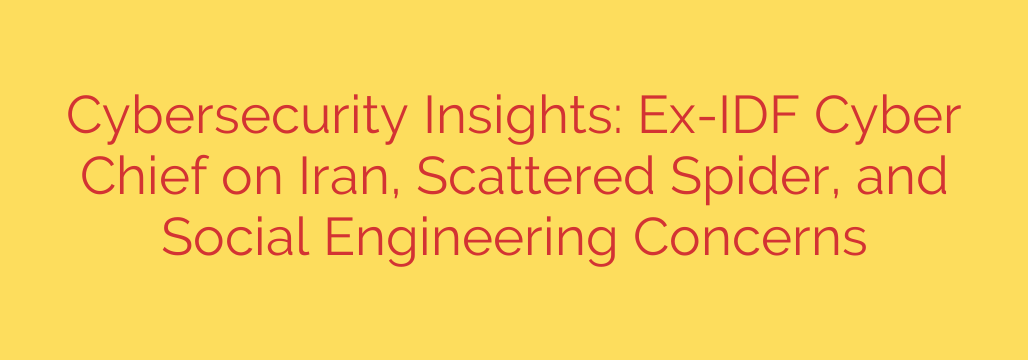
The New Frontline: Why Social Engineering is the Top Threat from Both Nation-States and Cybercriminals
The digital threat landscape is evolving at a breakneck pace. While technical defenses like firewalls and antivirus software remain essential, the most sophisticated attacks today are not aimed at code, but at people. From highly organized nation-state operatives to brazen young cybercriminals, attackers have identified a universal vulnerability: the human element.
Recent insights from top cybersecurity experts reveal a critical convergence in tactics. Whether the goal is geopolitical disruption or financial gain, the weapon of choice is increasingly social engineering—the art of manipulating people into divulging confidential information or performing actions that compromise security.
The Two Faces of Modern Cyber Threats
Today’s organizations face a dual threat from two very different types of adversaries. Understanding their distinct motivations and methods is the first step toward building a robust defense.
1. The Strategic Nation-State Threat
On one side, you have disciplined, patient, and well-funded threat actors operating on behalf of governments. These groups, often linked to nations like Iran, engage in cyber warfare as an extension of their geopolitical strategy. Their objectives are not typically quick financial payouts but long-term goals such as:
- Espionage and intelligence gathering
- Disrupting critical infrastructure
- Intellectual property theft
- Projecting international power
These attackers play the long game. They methodically probe defenses, establish persistent access, and wait for the opportune moment to strike. Their attacks are calculated, strategic, and represent a persistent, high-level threat to national security and corporate stability.
2. The Agile Financial Predator: Scattered Spider
On the other side of the spectrum are financially motivated cybercrime syndicates. A prominent example is the group known as Scattered Spider, a collection of native English-speaking, often younger attackers who have demonstrated terrifying proficiency in social engineering.
Unlike nation-states, their goal is immediate and clear: money. They are responsible for a string of high-profile ransomware and data theft attacks against major corporations. Their key characteristics include:
- Unmatched Social Engineering Skills: They are masters of vishing (voice phishing), impersonating IT help desk staff, and manipulating employees over the phone.
- Exploiting Trust: They target the most helpful parts of an organization, like the IT support desk, turning a company’s strength into a critical vulnerability.
- Technical Agility: They are quick to adapt, bypass security controls, and move laterally within a network once they gain initial access.
While their motives differ, both nation-states and groups like Scattered Spider have realized that the most significant vulnerability in any organization is not its software, but its people.
The Common Weakness: Why Social Engineering Works
Traditional security has focused on building higher digital walls. However, attackers are now simply walking through the front door by tricking an employee into opening it for them.
The core problem is that social engineering preys on basic human tendencies like helpfulness, trust, and a desire to avoid conflict. Attackers are increasingly adept at bypassing technical safeguards like Multi-Factor Authentication (MFA). They accomplish this through tactics like MFA fatigue, where they bombard a user with push notifications until the frustrated employee finally clicks “approve” just to make it stop.
They also manipulate IT help desks, which are trained to be helpful and resolve issues quickly. By impersonating a distressed employee who has lost their phone, an attacker can convince a support agent to reset credentials or add a new device to their account, giving them full access.
Actionable Steps to Fortify Your Human Firewall
Technology alone is not the answer. Organizations must invest in building a resilient “human firewall.” Here are essential, actionable steps to defend against these human-targeted attacks:
Conduct Continuous, Realistic Security Training: Annual, click-through training is no longer sufficient. Employees need ongoing education and simulations that mimic real-world vishing and phishing attacks. The goal is to build muscle memory for identifying and reporting suspicious requests.
Fortify Your Help Desk and IT Support: Your help desk is a prime target. Implement strict identity verification protocols that cannot be bypassed with easily obtainable personal information. Require multi-layered verification for sensitive actions like password resets or MFA device changes.
Move Beyond Basic MFA: While standard push-based MFA is better than nothing, it’s vulnerable to fatigue attacks. Organizations should prioritize adopting phishing-resistant MFA solutions, such as FIDO2-compliant security keys, which require a physical device and eliminate the risk of remote manipulation.
Cultivate a Culture of Healthy Skepticism: Employees must feel empowered to question unusual or urgent requests, even if they appear to come from a senior executive. Foster a no-blame security culture where reporting a potential mistake or a suspicious interaction is encouraged and rewarded, not punished.
In the end, cybersecurity readiness is no longer just about managing machines; it’s about empowering people. By understanding the motivations of diverse threat actors and hardening the human element against manipulation, organizations can build a truly resilient defense for the modern era.
Source: https://go.theregister.com/feed/www.theregister.com/2025/07/19/idf_cyber_chief_iran/








